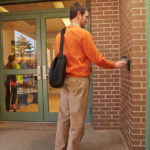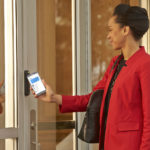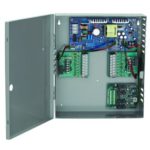 This post is going to require some patience and focus, but it’s an important one. I mentioned during my webinar last week that BHMA has submitted a code change proposal for the 2024 IBC, to try to address electrified hardware where the access control reader controls access but the door hardware allows free egress at all times. If this sounds familiar, maybe you read my recent Decoded article on the subject of Special Locking Arrangements vs. Normal Locking Arrangements.
This post is going to require some patience and focus, but it’s an important one. I mentioned during my webinar last week that BHMA has submitted a code change proposal for the 2024 IBC, to try to address electrified hardware where the access control reader controls access but the door hardware allows free egress at all times. If this sounds familiar, maybe you read my recent Decoded article on the subject of Special Locking Arrangements vs. Normal Locking Arrangements.
The reason this topic is so important is because on MANY occasions, I have been involved in situations where someone believed that every door with electrified hardware was a special locking arrangement. This led to attempts to apply one of the special locking arrangements sections of the model codes to a door opening that allows free egress. In terms of egress, these doors are essentially no different from a door that requires a key for access but allows free egress. But without a specific section to point to with regard to these systems (access control/free egress), it’s tough to explain. I once attended a hearing with the Massachusetts Board of Building Regulations and Standards, and I was unable to convince the board that the special locking arrangements sections did not apply to doors that allowed free egress (I held my tears of frustration until I got to my car).
In my opinion, the way to avoid these misinterpretations is to add a section to the model codes that we can refer to when there is electrified hardware that allows free egress at all times – this is the most common type of access control door. BHMA proposed a change for the 2024 IBC – you can read proposal E49-21 here.
When the ICC Technical Committee reviewed this code change proposal, their reaction was basically, “Why do we need a new code section just because people are misunderstanding the requirements? These doors allow free egress. The code is not concerned with ingress.” (I’m paraphrasing, but you can watch the video of the complete discussion here).
Here’s an example of a committee member’s comment, from Greg Grew: “I think that UL did the right thing when they issued that technical paper, that that’s how misunderstandings of the code should be addressed by the industry, but I really don’t think that this should be in the code just to prevent questions from building officials that don’t understand ingress.”
Based on the technical committee’s initial response and disapproval of the proposal, a public comment has been made to add a reference to these access control systems in an existing section of the IBC that addresses electrified hardware that monitors egress (the underlined phrases are the proposed changes):
1010.2.10 Monitored or recorded egress, and access control systems. Where electrical systems that monitor or record egress activity are incorporated, or where the door has an access control system, the locking system on the egress side of the door shall comply with Section 1010.2.11, 1010.2.12, 1010.2.13, 1010.2.14 or 1010.2.15 or shall be readily openable from the egress side without the use of a key or special knowledge or effort.
I think this would be a good compromise, because the openings that existing Section 1010.2.10 addresses do not inhibit egress – they only monitor and record who is exiting when. By also referencing access control systems in this paragraph, it allows doors with access control to comply with EITHER one of the special locking arrangements sections, OR to be readily openable from the egress side without the use of a key or special knowledge or effort (just like mechanical hardware).
IF this modification is approved, it would change the conversation:
AHJ: “The electrified hardware on this door has to comply with Section _________ [insert any of the special locking arrangements sections].”
Hardware Consultant: “Section 1010.2.10 allows access control hardware to comply with one of the special locking arrangements sections OR to be readily openable from the egress side without the use of a key or special knowledge or effort. The hardware on this door allows free egress at all times via normal operation of the door hardware, so it is not required to comply with the sections addressing special locking arrangements which do affect egress.”
AHJ: “All of the access control hardware must be listed to UL 294 – Standard for Access Control Systems Units.”
Hardware Consultant: “The UL 294 listing is required by Sections 1010.2.11, 1010.2.12, 1010.2.13, and 1010.2.14, but it is not required by Section 1010.2.10 for access control systems with electrified hardware that is readily openable from the egress side without the use of a key or special knowledge or effort.”
AHJ: “Thank you for the explanation!” 😉
Keep in mind that the ICC Technical Committee has not yet made a decision regarding this revised proposal. However, I expect that the 2021 IBC Commentary (available soon) will include some information that will help with field interpretations. I also have an ICC staff opinion specific to UL 294 not being required for access control systems that allow free egress, if you run into questions on that topic.
You need to login or register to bookmark/favorite this content.









As oft quoted::: from another post
What is wrong with the language already there
International Building Code states that “the unlatching of any door or leaf shall not require more than one operation.” The exceptions are 1) places of detention or restraint, 2) doors where manual flush bolts are allowed (more on that here), 3) doors with automatic flush bolts, and 4) doors from individual Group R dwelling units with an occupant load of 10 or less – a separate nightlatch, deadbolt, or security chain is allowed, as long as it doesn’t require a key or tool to release it from the interior.*
NFPA 101 states that the releasing mechanism on the door must not require more than one releasing operation, with the exception of residential dwelling units. The requirements for residential dwelling units are similar to the IBC – the separate lock on a dwelling unit door must be able to be released without a key or tool.* NFPA 101 does include an exception for existing hardware on rooms with an occupant load of 3 people or less, but technically the hardware would have to pre-date adoption of the requirement for one releasing operation; NFPA 101 has required one releasing operation since the 1988 edition. In the 2018 edition of NFPA 101, a change was made to allow a second releasing operation for existing classroom doors in K-12 schools, if certain criteria are met
One operation??
Hi Charles –
The problem is that SO MANY AHJs, architects, and others think that if a door has electrified hardware, it has to meet one of the code sections addressing special locking arrangements. I’d love to do a survey of AHJs (especially the ones who don’t know me) and see what percentage can answer this question correctly:
Which section of the IBC/IFC/NFPA 101 applies to a door equipped with electric latch retraction panic hardware, with an access control reader on the ingress side of the door?
Most wouldn’t know that electric latch retraction panic hardware allows free egress at all times, and only has to comply with the same egress requirements that apply to mechanical hardware. I think they see wires and they get nervous. I agree with you that the code already includes requirements for this hardware to comply with – one releasing motion to unlatch the door, readily openable with no key, tool, special knowledge, or effort, operable with no tight grasping, pinching, or twisting of the wrist, etc. But cumulatively I have spent years of my life trying to convince AHJs that the special locking arrangements sections don’t apply, and in some cases I have not been successful. The addition of UL 294 to the model codes made it worse, because some AHJs started asking for the listing on every single piece of hardware with a wire, even though the model codes only require the listing for certain types of systems.
– Lori
Well guess you cannot retire yet, till you educate the world!!!
Sorry,
Actually the Code Development Committee has heard and their recommendation is for Denial of the change. BHMA has submitted a public comment that will be heard at the hearings in Pittsburgh in a few weeks. Once the membership in attendance votes and the OGCV takes place, we will know the final disposition of this proposed change.
Even if the new language is not approved, the discussion of the proposal helps to establish the intent of the code so I appreciate that opportunity. In the past it has been my interpretation vs. someone else’s, which doesn’t always go well. 🙂
– Lori
it is frightening that AHJ’s do not under stand the difference.
I concur with the proposed change, acknowledging Charles’ very good point about keeping things simple and consistent.
You may have heard hardware engineers lament “We try to make things idiot proof, but they keep building better idiots.” So it is with today’s 1010; it’s not sufficiently idiot proof.
My 2 cents.